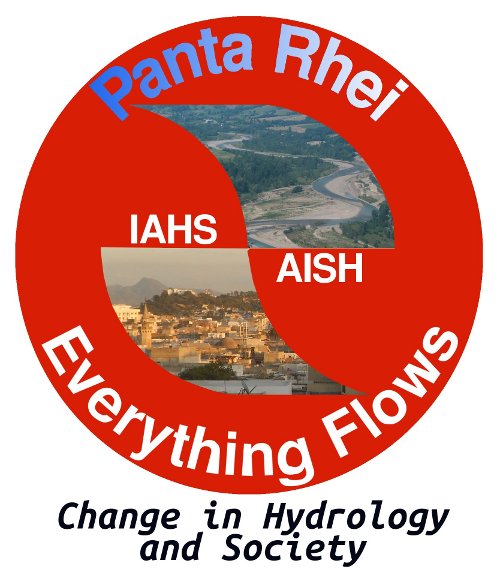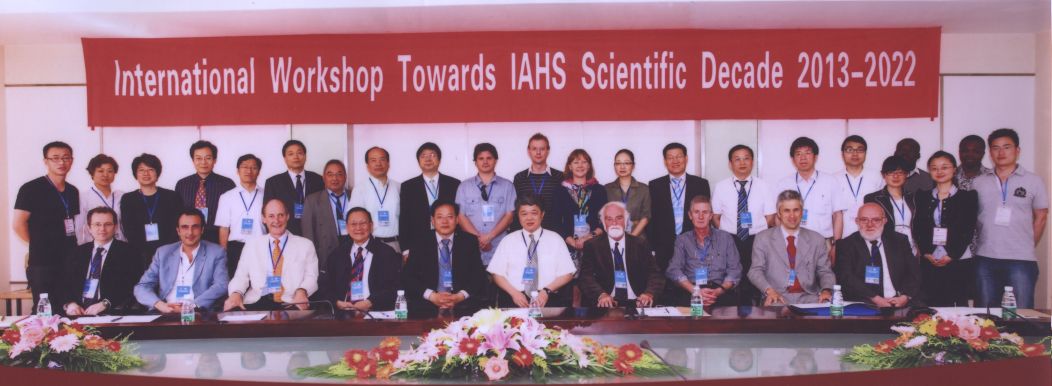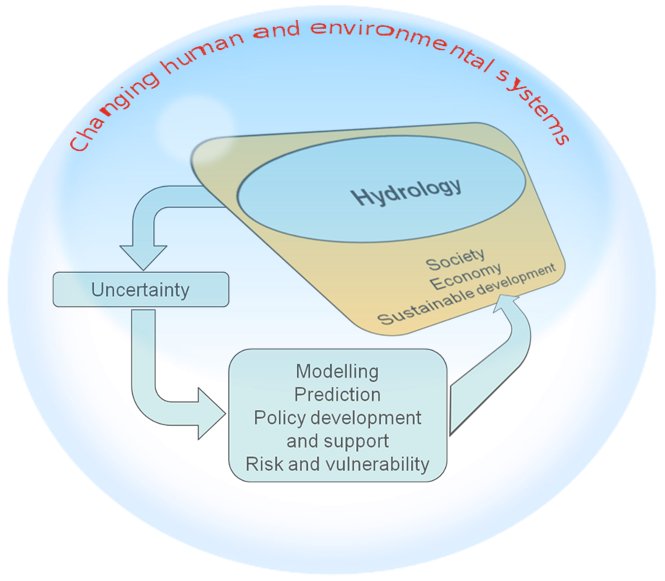Read all comments from beginning of discussion
 The discussion
The discussion hosted on this web page is dedicated to the new Science Initiative of the International Association of Hydrological Sciences (IAHS), to be launched in 2013. The aim of the discussion is to identify key scientific challenges for hydrology in the near future, therefore shaping the main focus of IAHS in the next years. Background on IAHS and how the initiative came about is given in the page “About the IAHS new Science Initiative” whose link is provided in the above menu.
Devising a scientific initiative in hydrology is an exciting and stimulating task. Such an ambitious target calls for a community brainstorming activity. In fact, a science initiative is indeed a community effort: ideas must reflect the feeling of as many scientists as possible. Although communication means are very efficient today, to launch a public discussion on scientific questions for the future and to draw a synthesis of its output is indeed a challenging aim.
When I was invited by IAHS to devise and moderate this discussion I felt very much honored. I think this is an extremely interesting experience that I accepted enthusiastically, but I immediately realized that I really need the help of the whole IAHS to carry out the task well. For this reason, after consulting with numerous colleagues and the IAHS Bureau, I decided to open this blog, which I hope will be able to reach out extensively to all IAHS members.
The question that I would like all readers to address is:
“What is your view on the most exciting research challenges for hydrologists in the next 10 years? What are the core questions hydrologists should address that will get a worldwide attention from the community?”
I sincerely hope that this public discussion, which will last for about 6 months, can effectively catch the attention of the IAHS community. I would like everybody, and in particular young scientists, to freely share their thoughts without being shy or concerned about whether their opinions fit in. Any suggestion could be the opportunity for all of us to get in touch with colleagues who could provide a substantial contribution during the subsequent development of the initiative. Summarizing the results of the discussion and writing a draft science plan is a daunting task for which we clearly need a diversity of views.
If you are still in doubt whether or not you should leave a comment on this blog, please contact me.
I am honored to have the opportunity to trigger the discussion by providing my view on the above key question. I’ll be very brief for now, because I want to leave the discussion fully open. Other TF members will provide their thoughts in the near future.
I do have some personal observations. I think one of the most exciting challenges for hydrologists in the future is to better understand how hydrological systems and processes react to changing conditions and forcings, in relation to societal development. In fact, water is facing rising pressures due to increased demands from a growing human population and changing lifestyles, and decrease of freshwater resources due to over-exploitation, land use and land cover changes, and resulting environmental pollution. This is the consequence of efforts to improve the quality of life and therefore it is a positive development. However, the sustainability of this development is questionable.
In fact, in many parts of the world the poor distribution of freshwater in relation to demand is already the cause of water scarcity, which may be exacerbated by climate change (Kundzewicz 2007; Koutsoyiannis et al., 2009; Blöschl and Montanari 2010; Wagener et al., 2010). Moreover, the effect of human activities on the water cycle is deepening and widening rapidly across the planet, driven by increased demands for energy (King and Webber 2008; Koutsoyiannis et al., 2009), water (Jackson et al. 2001), food (Vörösmarty et al., 2000) and living space (Zhao et al., 2001).
Therefore, relevant scientific questions arise about the sustainability of the above changes for hydrological systems and the related effects on society. To improve the societal management of natural resources implies gaining an improved understanding of hydrology. This is an evergreen of hydrology research but –alas – so much remains to be done. In particular, we need to gain a better insight into how water systems react to (rapid) change, by analyzing the two-way connection between society and these water systems (Sivapalan et al. in press, HP). In the non-linear, dynamic interplay of people and water systems complex and very surprising patterns may arise and these we need to understand for being prepared for the future water challenges.
In particular, to distinguish between human induced changes and hydrological variability seems to be a key issue to better understand the interaction with society and how changes will evolve in the future. Identification of change requires a better understanding of variability as a function of space and time scales.
What are the reasons for variability and how does variability scale across time and space? What are the footprints that may allow one to recognize change in (rapidly) varying signals? What are the reactions of systems to change and variability? What about the predicting capabilities? These are deep science questions and at the same time relevant for water management.
The above thoughts make me think that “change”, “variability” and “society” are likely keywords for hydrology in the near future. I believe that meaningful answers to the above questions require a deep understanding of the interactions of hydrological systems and humans in an interdisciplinary framework.
As I said, I would like not to go into details at the present stage. I am looking forward to numerous spontaneous feedback from all of you to better shape the above thoughts! Disagreement is particularly welcome.
Thank you for your interest.
All the best,
Alberto
References
Blöschl, G., Montanari, A., Climate change impacts-throwing the dice? (vol 25, pg 374, 2010), Hydrological Processes, 24, 1094-1094, 2010.
Jackson, R. B., S. R. Carpenter, et al., Water in a changing world, Ecological Applications 11, 1027–1045, 2001.
King, C., Webber, M., The Water Intensity of the Plugged-In Automotive Economy, Environmental Science and Technology, 42, 4305–4311, 2008.
Koutsoyiannis, D., C. Makropoulos, et al., HESS Opinions: Climate, hydrology, energy, water: recognizing uncertainty and seeking sustainability, Hydrology and Earth System Sciences, 13, 247–257, 2009.
Koutsoyiannis, D., Montanari, A., Lins, H.F., Cohn, T.A., Climate, hydrology and freshwater: towards an interactive incorporation of hydrological experience into climate research, Hydrological Sciences Journal, 54, 394–405, 2009.
Kundzewicz, Z. W., Mathematical modelling of ecohydrological systems in the changing world. Wetlands: Monitoring, Modelling and Management. T. Okruszko, E. Maltby, J. Szatylowicz, D. Swiatek and W. Kotowski, 151-159, 2000.
Sivapalan, M., Savenije, H.H.G., Blösch G., Socio-hydrology: A new science of people and water, in press on HPToday, 2011.
Vörösmarty, C. J., P. Green, et al., Global water resources: Vulnerability from climate change and population growth, Science 289(5477), 284–288, 2000.
Wagener, T., Sivapalan, M., Troch, P.A., McGlynn, B.L., Harman, C.J., Gupta, H.V., Kumar, P., Rao, P.S.C., Basu, N.B. and Wilson, J.S. 2010. The future of hydrology: An evolving science for a changing world. Water Resources Research, 46, W05301, doi:10.1029/2009WR008906.
Zhao, M., Pitman, A. J., Chase, T. N., The impact of land cover on the atmospheric circulation, Climate Dynamics, 17, 467–477, 2001.




 rather the main focus). Attention will be concentrated on understanding and modeling the two-way interactions between hydrological systems and society, which presupposes the study of how the hydrological systems themselves react to human-induced and natural changes.
rather the main focus). Attention will be concentrated on understanding and modeling the two-way interactions between hydrological systems and society, which presupposes the study of how the hydrological systems themselves react to human-induced and natural changes. breadth and generality of the above questions which should be coherent across all of them.
breadth and generality of the above questions which should be coherent across all of them.
